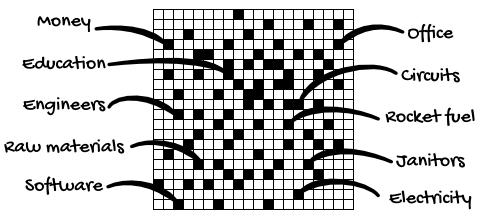I cleared my throat. "Most people can appreciate the level of intelligence and work required to build a business like, say, Elon Musk's SpaceX. Rockets don't just design and build themselves — there is a tremendous amount of coordination required to make that happen. Intelligence and work are essential to keep everything in a restricted, ordered state and resist the natural pull towards entropy. So, Zac, what are some resources that are required to build a reusable rocket?"
"Okay… umm… raw materials like aluminum and copper; circuits, screens, IT systems."
"What about all the human resources?" I said. "Engineers and other nerds, operations people, design people, janitors to clean the office. Oh, and you need an office and launchpad and all that stuff. And you need to educate those people, and you need furniture and supplies so they can work, and you need-"
"Money! Lots of money. Money from investors and selling stuff."
"Yes!" I said. "There are so many resources that combine together to create a reusable rocket, which is a highly, highly ordered creation. Think about it this way…" I pulled up another diagram.

"Before Elon Musk decided to build a reusable rocket, all these resources existed in a high entropy state. They were spread out all over the world. Engineers were working different jobs; money was deployed in different investments; the rocket fuel and raw materials existed under the ground somewhere. It took intelligence and work to combine all those resources into the specific form of a reusable rocket."

"Reusable rockets don't build themselves. Rocket fuel doesn't magically show up in the same location as the world's best engineers, and a pile of money — just like puzzle pieces don't magically fall out of the puzzle box, all in the perfect position.
All of these disordered resources need to be moved from a state of high entropy to a state of low entropy. That requires intelligence and work. Without intelligence orchestrating the system and keeping it in a low-entropy ordered state, everything would fall apart. The investors would put their money elsewhere; the staff would disband and find new jobs; the office would become run down. The whole system would entropy and die."
"Like a body…" Zac said.
"Yes! Like a body. Imagine your consciousness is the CEO of your body. The moment the CEO of your body dies, entropy ensues. Over time, your body will decompose and be recycled into the earth and spread out all over the place. Some of your body might end up in someone's food as they fly off to Mars on a reusable rocket. Some might end up as a fish scale, or a water droplet that then gets used in cotton production to produce a nice suit."
"So, is that a holographic pattern?" Zac asked. "My body is a system, but so is the business, right? And as long as there is a conscious focus on that system, it can resist entropy."
"Exactly," I said. "You'll notice this holographic pattern echoing at all levels of reality. To create something in particular — something in a low entropy state — you need to resist that natural pull towards entropy. If Elon Musk were to die and no one took his place as the head of SpaceX, the whole system would decompose. The engineers would find new jobs; the money would be pulled out of SpaceX and deployed elsewhere; the office would go to another company. Everything would disband, like a body decomposing into the ground.
Notice that the universe has this beautiful rhythm set up: the pull towards entropy, and the push against it. This push-pull rhythm is a creative process. If everything didn't naturally pull towards entropy, how could we ever recycle resources into new creations? You would die, and your body would remain intact forever. You'd create a business, and it would be that way forever. You can't create unless you can also de-create. Everything is building and destroying and re-building and re-destroying. It's a rhythm that you see everywhere in life and the universe. This de-creative process turns order into chaos.
We also need the inverse: the push against entropy — taking disordered resources and arranging them into low-probability ordered states. The creative process turns chaos into order. If we didn't have that opposing push, then we could never create something in particular. The fabric of spacetime would be completely smooth, with no mass distorting it. Relativity would disappear."
"What does that mean?" Zac asked.

